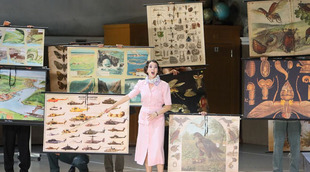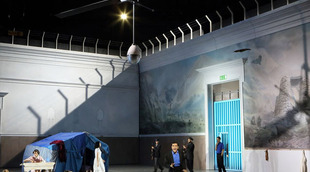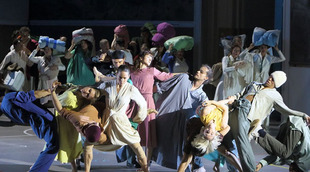 © Winfried Hösl
© Winfried Hösl


Jean Philippe Rameau has been a highly regarded composer during the French Baroque period and an important representative of the special French genre Opéra-Ballet, where music, stage and dance play an equal importance. The story is a typical baroque play of intrigues, jealousy, fidelity and love which can take place everywhere and does not really have any content. Les Indes galantes are sent over the exotic world to explore human relations of love, arriving in Peru, Turkey, North America and Europe.
Whereas Flemish director and choreographer Sidi Larbi Cherkaoui and his stage designer Anna Viebrock arrange the setting rather neutral in a monumental room which serves as a palace, a church, a courtyard or whatever inspiration by easy and fast changes. Four couples and their variable relations drive the story of the three hours long evening. Sidi Larbi Cherkaoui has gained international reputation for his extraordinary choreographies, as a mixture of classic dance, rap and street dance or theater dance, implementing influences from his Arab and African background, all with a strong artistic and powerful masculine body movement. The dancers of the Compagnie Eastman from Antwerpen are integrated in the story, acting as cleaners or servants. They hang around on stage or are quickly pushing moveable vitrines over the stage, apart from performing their expressive dancing. It is not evident to follow the single scenes on stage, which lack of flow and continuity. It is colourful, it is full of action, it is obsessive and blasphemous, but it is not touching, moving or narrative. There is no concept or conclusive theme in the interpretation.

Ivor Bolton acts similarly, uneven with his orchestra. He is certainly an expert for Baroque music, but here, the fine lyric French concept sounds often too sharp, too static or forward orientated, more like German Baroque music as of Händel or Bach. Most of the invited singers of the evening have to jump into two roles, an interesting study of their acting and singing flexibility representing different characters. In the first, the Turkish set, Joelie Harvey as Emille brings a fresh and young voice. Her height and her coloratura still need some more development. Tareq Nazmi, thanks to his size and full dark voice, is very present as Osman and later as Ali. Cyril Auvity does not leave many marks as Emile's beloved Valere nor as Tacmas. Anna Prohaska is Phani and Fatime, both roles are lovely modelled and sung by her. Her voice and intonation are clear, flexible with soft edges. Francois Lis tries hard to give his role of Huascar more expression, as it is implemented in the strange definition by the direction. His warm and sensible bass succeeds better as Don Alvaro. Lisette Oropesa brightens her soprano in clear and silver heights but diminishes slightly in climbing down or smoothly crescendi and decresendi. There is an exaggerated warm and loud applause for all the participants and the direction team by the specific admirers of Sidi Larbi Cherkaoui. This interpretation of one of the major works of Jean Philippe Rameau is certainly not a milestone, but it is still a well sounded, colourful and entertaining evening.
Helmut Pitsch
Les Indes galantes at the Bayrische Staatsoper, Munich, from July 24th to 30th
the 03 of August, 2016 | Print
Comments